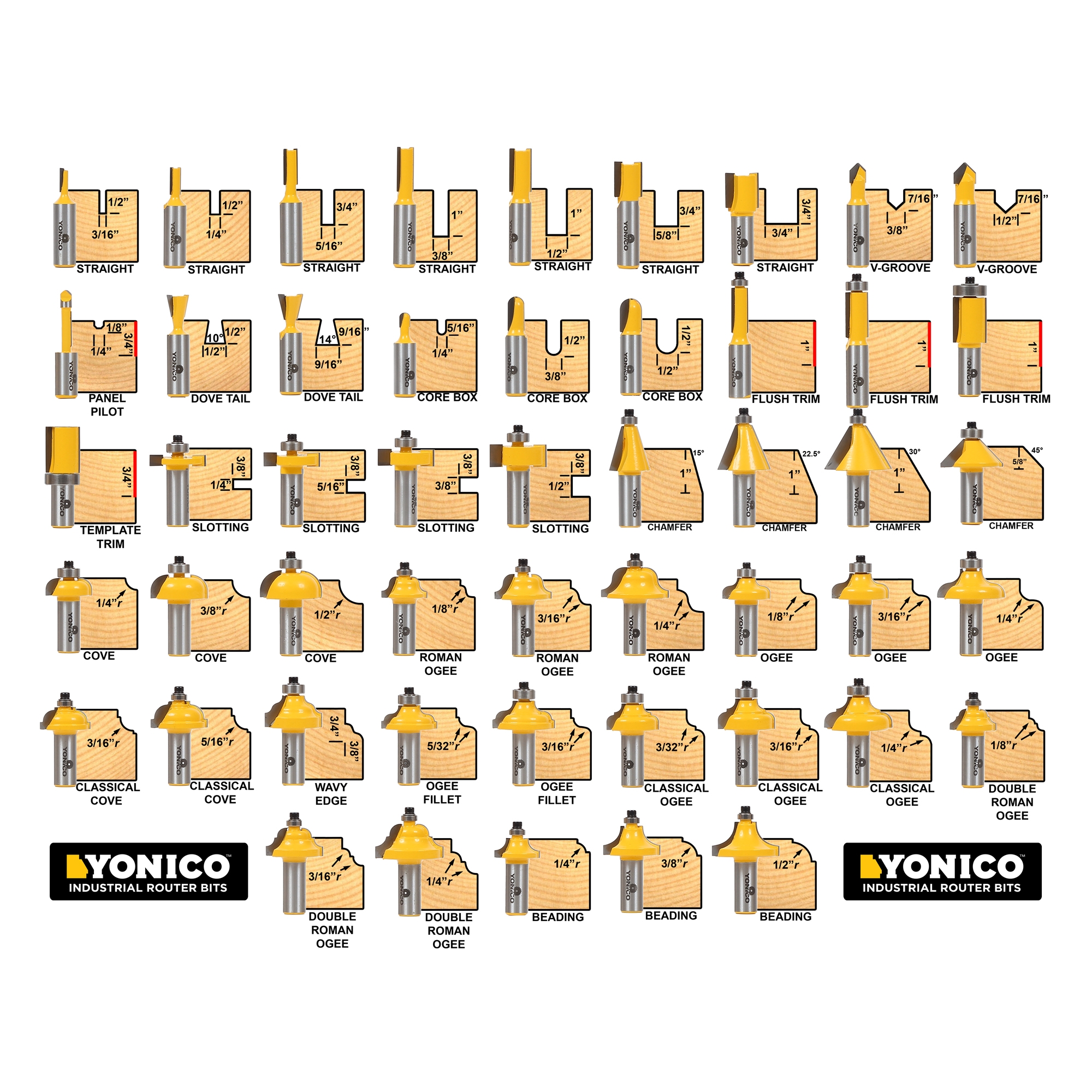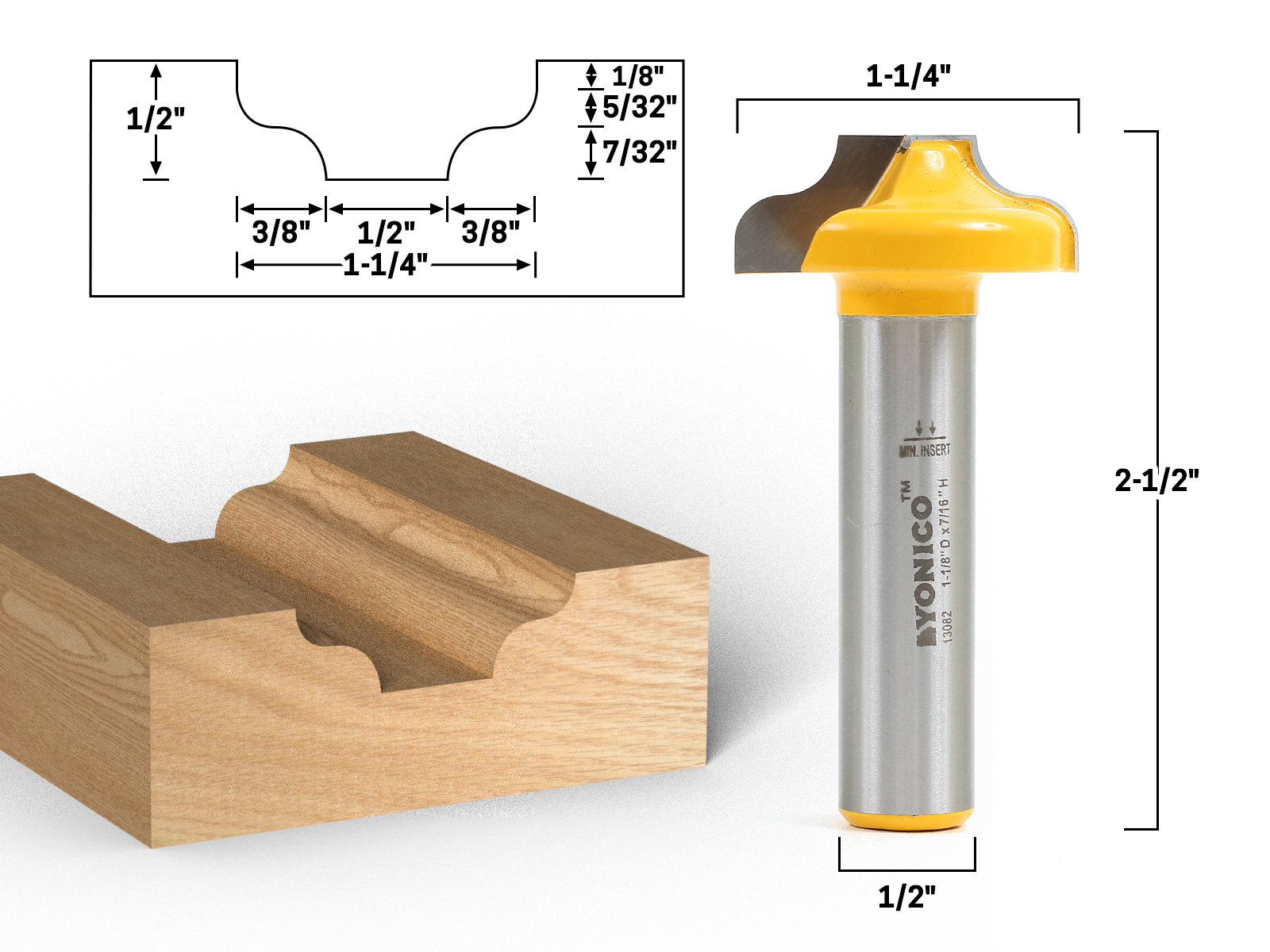Router Bit Profiles for Cabinet Doors

Router bit profiles play a crucial role in achieving the desired aesthetic appeal of cabinet doors. They determine the shape and design of the door’s edge, adding visual interest and enhancing the overall look of the cabinetry. Selecting the right router bit profile can transform a simple cabinet door into a stunning design element, complementing the style and theme of the kitchen or any other room.
Types of Router Bit Profiles for Cabinet Doors
Router bit profiles for cabinet doors come in a wide variety, each offering a unique visual impact and functionality. Understanding the different types of profiles is essential for choosing the best option for your project. Here are some of the most commonly used router bit profiles for cabinet doors:
- Raised Panel: This profile features a raised center panel surrounded by a recessed frame, creating a classic and elegant look. Raised panel doors are commonly used in traditional and formal settings.
- Ogee: This profile is characterized by a curved, S-shaped design with a prominent lip. Ogee profiles add a touch of sophistication and are often used in more contemporary or transitional styles.
- Beaded: This profile features a series of small, rounded beads along the edge of the door, creating a simple yet elegant look. Beaded profiles are versatile and can be used in various styles, from traditional to modern.
- Flush: This profile has a flat surface with no raised or recessed areas, offering a clean and minimalist aesthetic. Flush doors are ideal for modern and contemporary designs.
- Shaker: This profile features a simple, rectangular frame with a flat center panel, offering a clean and timeless look. Shaker doors are popular for their versatility and ability to complement various styles.
Comparing Router Bit Profiles
The following table compares the characteristics, applications, and visual impact of different router bit profiles for cabinet doors:
| Profile | Characteristics | Applications | Visual Impact |
|---|---|---|---|
| Raised Panel | Raised center panel surrounded by a recessed frame. | Traditional, formal, and classic styles. | Elegant, classic, and sophisticated. |
| Ogee | Curved, S-shaped design with a prominent lip. | Contemporary, transitional, and modern styles. | Sophisticated, elegant, and eye-catching. |
| Beaded | Small, rounded beads along the edge of the door. | Traditional, modern, and contemporary styles. | Simple, elegant, and versatile. |
| Flush | Flat surface with no raised or recessed areas. | Modern and contemporary styles. | Clean, minimalist, and sleek. |
| Shaker | Simple, rectangular frame with a flat center panel. | Traditional, contemporary, and transitional styles. | Timeless, versatile, and clean. |
Selecting the Right Router Bit Profile for Your Project

Choosing the right router bit profile is crucial for achieving the desired look and functionality for your cabinet doors. The profile you select will significantly impact the overall aesthetic and style of your cabinets.
Factors to Consider When Selecting a Router Bit
The selection of a router bit involves considering several factors, including size, bearing diameter, and cutting depth.
- Size: Router bits are available in various sizes, measured in inches or millimeters. The size of the bit determines the width of the profile you create.
- Bearing Diameter: The bearing diameter determines the size of the profile’s radius. A larger bearing diameter will result in a wider radius, while a smaller bearing diameter will produce a tighter radius.
- Cutting Depth: The cutting depth determines the depth of the profile. It is essential to select a bit with a cutting depth that is appropriate for the thickness of your cabinet door material.
Matching Router Bit Profiles to Cabinet Door Styles
The selection of a router bit profile is directly influenced by the desired cabinet door style.
- Raised Panel Doors: Raised panel doors typically feature a flat center panel surrounded by a raised frame. A variety of router bit profiles can be used to create the raised frame, including ogee, cove, and bead profiles. An ogee profile is a popular choice for creating a traditional look, while a cove profile can create a more modern aesthetic. A bead profile can add a simple, decorative element to the frame.
- Slab Doors: Slab doors have a flat surface with no raised panels. For slab doors, a simple router bit profile can be used to create a subtle edge detail, such as a chamfer or a rounded edge.
- Shaker Doors: Shaker doors are known for their simple, clean lines and flat panels. A router bit profile can be used to create a subtle detail around the edges of the panels and the frame, such as a simple bead profile or a chamfer.
Example Router Bit Profiles for Different Cabinet Door Styles
The following table illustrates the relationship between cabinet door styles and recommended router bit profiles:
| Cabinet Door Style | Recommended Router Bit Profile |
|---|---|
| Raised Panel | Ogee, Cove, Bead |
| Slab | Chamfer, Rounded Edge |
| Shaker | Bead, Chamfer |
Mastering Router Bit Techniques for Cabinet Doors: Router Bit Profiles For Cabinet Doors

Creating precise and intricate profiles on cabinet doors is a skill that can elevate woodworking projects from good to exceptional. Router bits, with their versatility and accuracy, are essential tools for achieving these profiles. Mastering router bit techniques for cabinet doors involves understanding the setup, safety precautions, and proper technique for achieving clean, precise cuts.
Router Bit Setup and Safety
Proper setup and safety practices are crucial for successful and safe routing. Before starting, it is important to ensure the router is securely mounted on a stable base. The router bit should be properly installed and secured in the collet. The depth of cut should be set according to the specific bit and the desired profile.
- Secure Mounting: Ensure the router is mounted on a stable and secure base. A router table is ideal for creating consistent profiles, but a router jig can also be used for increased accuracy.
- Proper Bit Installation: Always install the router bit according to the manufacturer’s instructions. Ensure the bit is securely tightened in the collet.
- Depth Adjustment: Set the depth of cut to match the desired profile. Use a depth gauge or the router’s built-in depth adjustment mechanism for accurate settings.
- Safety Gear: Wear safety glasses, hearing protection, and a dust mask to protect yourself from flying debris and dust.
- Clear Work Area: Keep the work area free of clutter and ensure adequate lighting.
- Avoid Distractions: Focus on the task at hand and avoid distractions.
Routing a Raised Panel Cabinet Door, Router bit profiles for cabinet doors
Routing a raised panel cabinet door involves creating a recessed panel that sits below the surrounding frame. This process requires precise cuts and careful technique.
- Prepare the Door: Ensure the door is properly sized and that the panel is cut to fit. Use a pencil to mark the Artikel of the panel recess on the door face.
- Initial Routing: Set the router bit depth to about half the desired panel depth. Route the Artikel of the panel recess, making shallow passes to avoid tear-out.
- Increase Depth: Gradually increase the router bit depth, making multiple passes until the desired panel depth is achieved.
- Clean Up: Use a chisel or scraper to clean up any remaining material around the panel recess.
- Finishing: Sand the door to remove any rough edges and prepare for finishing.
Router Bit Attachments and Accessories
Various attachments and accessories can enhance accuracy and efficiency when routing cabinet door profiles.
- Edge Guide: An edge guide helps maintain consistent distance from the edge of the workpiece, ensuring straight and parallel cuts.
- Template Guide: A template guide allows for the creation of intricate and repetitive profiles by following a pre-cut template.
- Dust Collection System: A dust collection system helps keep the work area clean and reduces the amount of dust inhaled.
- Router Table: A router table provides a stable platform for the router and allows for more precise control over the routing process.
Router bit profiles for cabinet doors offer a wide range of design possibilities, from classic raised panels to modern, sleek edges. A popular choice for achieving a timeless look is to pair wood cabinets with stainless appliances with wood cabinets , creating a sophisticated contrast.
Whether you prefer a subtle chamfer or a dramatic ogee profile, the right router bit can elevate your cabinet doors and contribute to the overall aesthetic of your kitchen.
Router bit profiles for cabinet doors offer a vast range of options, from simple bevels to intricate raised panels, allowing for a personalized touch. For a vintage aesthetic, consider the classic designs found on antique wooden file cabinets 3 drawer , which often feature elegant moldings and intricate carvings.
These details can inspire your own router bit choices, adding depth and character to your cabinet doors.
